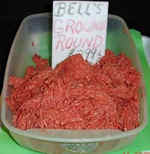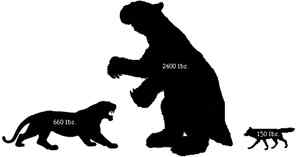 Hamburger doesn’t fight back. A ground sloth wasn’t your average prey species–it would have been a challenge bringing down a healthy adult. Greg McDonald says an average full-grown Megalonyx weighed approximately 2400 pounds (McDonald, 2005). There’s some uncertainty about their weight, as you might imagine, given the paucity of complete skeletons, but let’s go with it. Besides, that’s probably a conservative estimate–our adult was a lot larger than average.
Hamburger doesn’t fight back. A ground sloth wasn’t your average prey species–it would have been a challenge bringing down a healthy adult. Greg McDonald says an average full-grown Megalonyx weighed approximately 2400 pounds (McDonald, 2005). There’s some uncertainty about their weight, as you might imagine, given the paucity of complete skeletons, but let’s go with it. Besides, that’s probably a conservative estimate–our adult was a lot larger than average.
 Best estimates put the weight of adult dire wolves at about 150 lbs. (Lange, 2002). Sabertooth cats weighed in at 660 lbs http://genericoitalia.it/. (Barton et al., 2002. In other words, these two formidable predators weighed just 6% and 25% of the average Megalonyx. Putting that in a human perspective, that’s a predator of 10 lbs. and 45 lbs. respectively — house cat and dalmation-sized, assuming an adult human weight of 175 pounds–nothing to lose any sleep over.
Best estimates put the weight of adult dire wolves at about 150 lbs. (Lange, 2002). Sabertooth cats weighed in at 660 lbs http://genericoitalia.it/. (Barton et al., 2002. In other words, these two formidable predators weighed just 6% and 25% of the average Megalonyx. Putting that in a human perspective, that’s a predator of 10 lbs. and 45 lbs. respectively — house cat and dalmation-sized, assuming an adult human weight of 175 pounds–nothing to lose any sleep over.
There’s some debate about whether the sabertooth was a solitary or social hunter, but one thing is sure—any predator that hunted Megalonyx needed lots of help. That’s important because Haynes says packs of predators eat in highly predictable ways. Next post: Haynes’s signs of predation. Dave
References
Barton, M., Dunleavy, S., Gray, I., White, A. 2002. Prehistoric America: A journey through the ice age and beyond. Yale University Press, New Haven CT.
Lange, IM. 2002. Ice Age Mammals of North America: A guide to the big, the hairy, and the bizarre. Mountain Press Publishing Co., Missoula, MN.
McDonald, HG. 2005. Paleoecology of extinct Xenarthrans and the great American biotic interchange. Bulletin of the Florida Museum of Natural History 45: 313-333.

I always have a number of thoughts when it comes to predation on sloths.
The first deals with the lack of evidence of predation on the remains known so far. There might be some signs on the specimens from La Brea, but who couldn’t resist trying to take a scavenging nip?? I believe there is some evidence of rodent gnawing on the Tarkio sloth, which would also fall under the category of scavenging.
Still, the lack of evidence on remains from other localities makes me skeptical of anything truly targeting sloths for feeding. Take into account their size and defenses (see Farina & Blanco, 1996 for defensive/offensive abilities), and it seems more unlikely. Thick hides, large flat ribs and massive claws provide a host of defenses and weapons.
Not to say that it wouldn’t be more realistic for a predator to target juveniles, as many hunters tend to thin the ranks of the young and old, but here we have further evidence of family structure within a cohort of ground sloths that would have made such “easy pickings” not so easy. We have no idea how long the juveniles would have remained with the adult, but the longer the stay the greater increase in size and therefore the declining predation potential.
I’m always curious about the effects of an animal’s diet on the taste of its meat. We know some of the ways it effects cattle, so why shouldn’t some of those principles apply to fossil taxa? Granted we don’t know for sure what the diet of Megalonyx consisted of but we know what it was for Nothrotheriops, and so a guestimation of sloth flavor could be made. To that end, while it may have looked like a big, appetizing meal, would it really have tasted that good??
Hi Rob,
Ground sloths as predatory “stabbers” shines a new light on the potential capabilities of the animals. I agree with you–healthy adult sloths were probably safe from predators, but juveniles . . . maybe a different matter. Were you aware, in addition to the minor scavenging signs, we found a deep wound in a rib from the toddler’s back? It started healing, so it wasn’t an easy catch as you suggested. It’s possible the juvenile fell on something sharp or that another sloth swatted it, but a predator claw or canine makes more sense to me. What do you think? It would be nice to know how debilitating the wound was, if there is evidence the infection penetrated into the lung cavity, the extent of the infection, the symptoms. . . we need a Pathologist. It could lend a lot of credence to your idea about the importance of social support within the group, which would almost have to be a family then, wouldn’t it? I’ll supply more details in the future and post the CT scan we took.
Our museum guests often want a logical explanation for how a slow moving animal like a tree sloth can survive in the wild and the idea of tasting bad seems to have entered popular folklore. I usually remind guests that moving slowly is a survival strategy for tree sloths, and ground sloths weren’t likely as slow or as worried about predators, and hence no reason to taste bad either.
We have some Shasta sloth poop here. I’ll open the jar and let you sniff the next time you come in. . . . Not bad at all, probably make a lot of Iowa cows envious.
I’m not aware of anyone who has written authoritatively on the subject of sloth taste, are you? By all accounts, armadillos taste pretty good. And there’s a note on the Smithsonian Institution web site that hunting is a greater threat to Giant Anteaters in Brazil than habitat loss because their meat tastes so much better than other wild game. (see http://www.nationalzoo.si.edu/Publications/ZooGoer/2007/6/Strange-Joints.cfm)
The only tree sloth reference I’ve found simply says, who would bother to eat them? . . . they’re tough and stringy because of their low muscle mass, though raptors and jaguars don’t seem to mind the texture or the taste. My position is if people can eat arugula then sabertooths and dire wolves could probably choke down a megalonyx steak.
Thanks for the offer but I’ve already had my experiences with Shasta dung. In fact, you’ll find my name on some documents in the Smithsonian collections with some of the samples if you open the right drawer.
I’m glad to hear you’re not touting the belief that the grounds sloths were as slow as the extant ones. You’re got it right on the survival strategy, and if anyone has ever seen a giant anteater on the move they know that a low metabolic rate isn’t slowing that thing down!
As for taste, there was a botanist of sorts for a few years at NIU who said he’s actually had sloth soup from some native tribe while down the South American way. He didn’t have much to say about it other than being rather bland. Given the adaptations the tree sloths have for continued hanging without much physical exertion, that their muscle is predominantly made of white muscle fibers makes sense and I’m sure has an effect on the taste.
As such, perhaps using the tree sloths as an estimation of taste isn’t appropriate since the ground sloths would have likely had a higher ratio of red muscle fibers, which would probably make it tastier on par with the armadillos and anteaters.
I’m still looking for references to follow up this idea of mine as it relates to taste, but I think human evolution and dispersal has been aided by our declining taste. Humans maybe be able to choke down some questionable things but how much of that can also be correlated to a decrease in active genes for our smell receptors? There are correlations between smell and taste, and genetics have shown a decrease in the receptor proteins that get made for humans versus animals with a better sense of smell. So my musing here is really how picky are the tastes of other animals with a greater sense of smell? And did the loss of odor sensitivity in humans result in less selective tastes and allow for more a wider variety of food items to be ingested?